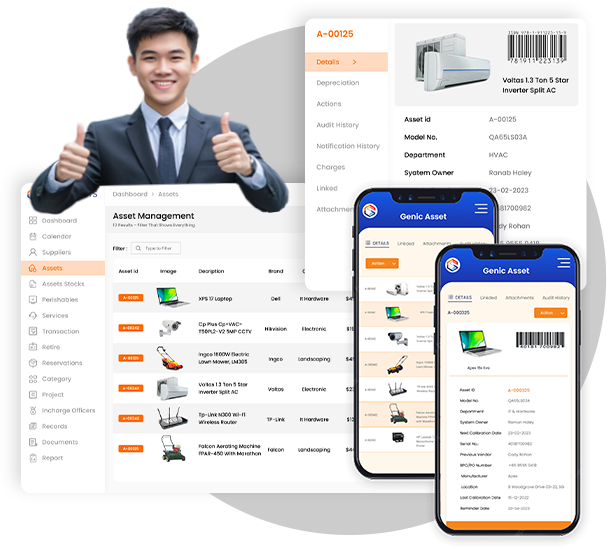The Benefits of Implementing an Asset Management System in Australia
Running a business without control over assets can cause confusion, waste, and loss. In Australia, firms in sectors like healthcare, construction, and field services handle thousands of tools, machines, and vehicles.
Without proper tracking, teams misplace equipment, double-purchase items, or forget to service critical machines. An asset management system in Australia brings order to the chaos.
It maps, tracks, and manages tools and resources with clarity, giving leaders the power to steer operations with precision.
What is an Asset Management System
An asset management system helps teams identify, track, and optimise every item they own. From computers and vehicles to tools and spare parts, it logs each asset's location, status, and usage. It connects the dots between planning, performance, and maintenance.
Unlike manual methods like spreadsheets or whiteboards, these systems update in real-time and offer full visibility. Firms that install a robust asset solution notice fewer breakdowns, quicker audits, and lower costs.
Why Australian Businesses Must Act
Australia’s harsh terrain, wide distances, and strict safety laws make asset control vital. In remote areas, missing a generator or service vehicle can halt work for days. City-based offices also struggle when laptops vanish or medical devices skip their service dates.
Many companies rely on outdated tools. These fail to handle the demands of modern work. On the other hand, Enterprise Asset Management Solutions Australia offer smart, mobile-ready features that adapt to varied industries and regions.
Challenges Without a System
Duplicate purchases from poor records
Delayed jobs due to missing tools
Unplanned breakdowns
Costly fines for skipped maintenance
Time-consuming audits
Switching to a digital asset system solves these issues. It tracks usage, prevents overlap, and flags assets before they fail.
Benefits of a Modern Asset System
1. Improved Tracking and Visibility
With a smart system, every asset tells a story. You can view its location, who used it last, and when it next needs care. Real-time dashboards help managers take fast, firm decisions.
For example, a healthcare firm may track all X-ray machines. With one glance, they’ll know if a machine stands idle, needs a service, or sits in storage.
2. Lower Costs and Waste
When assets disappear or sit unused, money vanishes too. An asset system cuts these losses. It shows what tools you already own, stopping needless buys. It also keeps schedules tight, reducing repair bills and boosting asset life.
Many firms report fewer purchases and better usage after they adopt smart tracking.
3. Stronger Compliance and Safety
In sectors like healthcare, mining, or transport, missed service checks can lead to harm. A good system prevents this. It sends alerts before deadlines and keeps logs for audits.
No more guessing when a vehicle needs inspection. The system reminds you, stores proof, and guards your team and business from fines.
4. Fast, Accurate Audits
Manual asset counts take weeks. Errors creep in. But with a digital platform, audits finish in hours. Barcodes, QR tags, and mobile apps make scanning fast and easy.
Let’s explore how an asset system compares with manual tracking methods.
Table 1: Manual vs Digital Asset Tracking
This table shows how much efficiency grows when firms shift from pen-and-paper or spreadsheets to smart systems.
How Enterprise Asset Solutions Support Field Work
Field teams often work far from head offices. They carry vital tools, drive company vehicles, and face tight timelines. Without real-time tracking, they may lose tools, delay jobs, or miss service deadlines.
Enterprise Asset Management Solutions Australia helps field crews by offering mobile features. Workers scan assets on the go, log usage, and request repairs from job sites. Managers watch it all from one dashboard.
These systems also help companies shift from reactive to planned maintenance. Instead of fixing things only when they break, teams now service tools at set times. This keeps gear healthy, reduces downtime, and improves safety.
Enhancing Productivity Across All Departments
From accounts to operations, everyone benefits. Finance gets cleaner reports. Operations see what works and what doesn’t. Maintenance teams schedule better. Even HR tracks staff-assigned equipment with ease.
Table 2: Departmental Gains from Asset Systems
Each department saves time, avoids errors, and gains control, thanks to better data and insight.
Custom Fit for Australian Conditions
Australia has unique challenges—vast spaces, remote teams, and strict rules. A tailored asset system suits these needs. It works offline in outback zones, supports mobile crews, and meets local standards.
Long-Term Value Over Quick Fixes
Some firms try free tools or patchwork fixes. These offer short-term relief but fall short under pressure. A robust system may need some setup time, but it repays quickly.
Downtime drops
Assets last longer
Repairs shrink
Staff feel confident using well-tracked tools.
Once installed, firms rarely go back. The clarity and speed change how work flows.
Integration with Other Business Systems
An asset system grows more powerful when it talks to your other tools. Linking it with finance, HR, or inventory platforms helps data flow cleanly. Integration avoids duplicate entries and gives each team up-to-date information. It also improves planning and cuts administrative load. Businesses work smoothly and make quicker choices.
Sync asset data with accounting for real-time values
Link HR to track staff-issued tools and devices
Update stock levels automatically with inventory tools.
Streamline asset request workflows between departments
Reduce errors and manual work through automation.
Final Thought
Australian firms face strong pressure to track tools, meet rules, and cut waste. Without the right system, assets fall through the cracks. A smart asset management system in Australia changes this. It brings control, saves money, and boosts safety across every team.
By moving from clutter to clarity, firms unlock growth and stay ahead in tough markets. Whether you're a city office or a bush crew, the right system helps you move faster and work smarter.



Comments
Post a Comment